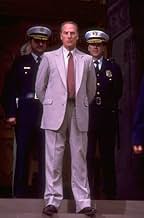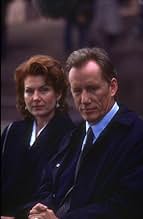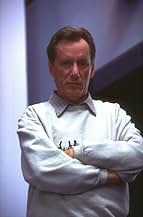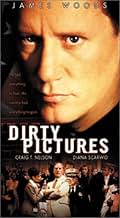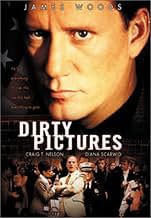Füge eine Handlung in deiner Sprache hinzuA Cincinnati museum director goes on trial in 1990 for exhibiting sadomasochistic photographs taken by Robert Mapplethorpe.A Cincinnati museum director goes on trial in 1990 for exhibiting sadomasochistic photographs taken by Robert Mapplethorpe.A Cincinnati museum director goes on trial in 1990 for exhibiting sadomasochistic photographs taken by Robert Mapplethorpe.
- Für 2 Primetime Emmys nominiert
- 4 Gewinne & 6 Nominierungen insgesamt
Empfohlene Bewertungen
This film deals with the same 1st Amendment rights issues as THE PEOPLE VS. LARRY FLYNT. It presents the case of the Cincinnati art museum that displayed the photography of Robert Mapplethorpe. Intercut with the action of the film are comments from both the political right and left, including Mapplethorpe himself.
The song "Banned in the USA," a "Born in the USA" parody dealing with censorship, sums up the point -- that if some people protest against what other people want, that's fine, but if the protestors try to impose their own will through misapplication of law, that is not only censorship but also the first step towards dictatorship hiding under the guise of benevolent morality.
The cast is strong, especially James Woods as the museum director. The plot meanders back and forth in time, giving us background and consequences woven together into an intriguing story. The issues raised are important, and the dramatic presentation of these issues makes the film worthwhile.
The song "Banned in the USA," a "Born in the USA" parody dealing with censorship, sums up the point -- that if some people protest against what other people want, that's fine, but if the protestors try to impose their own will through misapplication of law, that is not only censorship but also the first step towards dictatorship hiding under the guise of benevolent morality.
The cast is strong, especially James Woods as the museum director. The plot meanders back and forth in time, giving us background and consequences woven together into an intriguing story. The issues raised are important, and the dramatic presentation of these issues makes the film worthwhile.
More people need to see this film. It's an important one.
This film was nominated for a number of awards and won the Golden Globe for Best Miniseries or Motion Picture Made for Television.
The right to personal freedom is something that many have given their lives for over the course of history. This film really helps people understand that our freedoms are constantly under attack, continuously in jeopardy. You don't have to agree with what your neighbor may enjoy, and they you. This is the necessary understanding it takes to defend and uphold personal freedom. In allowing your fellow citizens to be free in their choices within the law, you are also defending your own freedom. This understanding, this knowledge of respecting your fellow citizens right to chose, even if you do not like their choice is the very basis of the 1st Amendment of the Untied States. Freedom of speech and beliefs, and the right to free expression itself, is essentially protected under this very idea/amendment. Nonetheless, everyday, in one way or another it's very relevance, value and existence is challenged in society.
As it is said in the film, we lose our freedom only a little at a time. If people do not fight for it continuously. The closed minded, scared and the obsessive control freak type of people, will eventually little by little take away all the freedoms that so many have given their lives for. People have fought wars to maintain the freedom we have to do what we want within our own homes, and to say and believe what we want in a public space. Not only the fearful, but also the ruthlessly greedy are constantly on the march to rob human beings of these very important aspects of life. At this point, most of us take it for granted, and if too many of us do. We will inevitably become like many other countries around the world, where your right to what you do in private is not nearly so valued, nor your right to free public expression. Instead of being looked at as a human being of unknown potential. You could be looked at as a possible threat to societal order. Many countries function not a lot differently than prisons in truth. From courageous historical figures, to modern soldiers and the children of today and tomorrow. We all owe it to them, those who value our personal right to grow as we see fit within the normal confines of the law to appreciate what we have. To stand up for your fellow neighbors right to be who they are and do what they do, as long as it's within the law of course. Law itself in the countries that value personal freedom, is truly built mostly upon an old sacred understanding. If a person is doing something that forcefully goes against another person's will, and if it effects them beyond reason, then it is illegal. Reasonable boundaries are set at what people can do to another in any circumstance. This is essentially the basis of law between human to human interactions in reasonably free countries. The importance of these things is brought to great light in this film about a true story in the American art world. If you can stand the 'dirty pictures', this is a very important film to see.
As a film, it's not perfect. It feels somewhat like a film in parts, because there are a few fairly typical clichés/scenes, and it is somewhat predictable a person could even say. Nonetheless, the story itself is so important and in my view very well told, in that it hits almost every important point about it's main topic. In this way, the film is great. I always base the vast majority of my film ratings upon the stories first and foremost. I don't need to see a perfectly lit and shot film in order for me to highly rate it. The film overall just needs to be effective in what it's setting out to say or do. Some films defy standard formulas entirely, and even reason itself, but nonetheless story for me is the main and most important ingredient in the vast majority of films. Here, we have mostly a very strong story that needs to be seen and talked about by mature adults. Chaplin is actually a great example. He was a very standard film director, almost everything was just point and shoot. But one of the things that made him special, is that he was an extremely talented and effective storyteller. The way his films look matters little, because the stories themselves are often so brilliant, relevant and/or important.
One last point, James Woods gives a great performance here.
8.5/10.
This film was nominated for a number of awards and won the Golden Globe for Best Miniseries or Motion Picture Made for Television.
The right to personal freedom is something that many have given their lives for over the course of history. This film really helps people understand that our freedoms are constantly under attack, continuously in jeopardy. You don't have to agree with what your neighbor may enjoy, and they you. This is the necessary understanding it takes to defend and uphold personal freedom. In allowing your fellow citizens to be free in their choices within the law, you are also defending your own freedom. This understanding, this knowledge of respecting your fellow citizens right to chose, even if you do not like their choice is the very basis of the 1st Amendment of the Untied States. Freedom of speech and beliefs, and the right to free expression itself, is essentially protected under this very idea/amendment. Nonetheless, everyday, in one way or another it's very relevance, value and existence is challenged in society.
As it is said in the film, we lose our freedom only a little at a time. If people do not fight for it continuously. The closed minded, scared and the obsessive control freak type of people, will eventually little by little take away all the freedoms that so many have given their lives for. People have fought wars to maintain the freedom we have to do what we want within our own homes, and to say and believe what we want in a public space. Not only the fearful, but also the ruthlessly greedy are constantly on the march to rob human beings of these very important aspects of life. At this point, most of us take it for granted, and if too many of us do. We will inevitably become like many other countries around the world, where your right to what you do in private is not nearly so valued, nor your right to free public expression. Instead of being looked at as a human being of unknown potential. You could be looked at as a possible threat to societal order. Many countries function not a lot differently than prisons in truth. From courageous historical figures, to modern soldiers and the children of today and tomorrow. We all owe it to them, those who value our personal right to grow as we see fit within the normal confines of the law to appreciate what we have. To stand up for your fellow neighbors right to be who they are and do what they do, as long as it's within the law of course. Law itself in the countries that value personal freedom, is truly built mostly upon an old sacred understanding. If a person is doing something that forcefully goes against another person's will, and if it effects them beyond reason, then it is illegal. Reasonable boundaries are set at what people can do to another in any circumstance. This is essentially the basis of law between human to human interactions in reasonably free countries. The importance of these things is brought to great light in this film about a true story in the American art world. If you can stand the 'dirty pictures', this is a very important film to see.
As a film, it's not perfect. It feels somewhat like a film in parts, because there are a few fairly typical clichés/scenes, and it is somewhat predictable a person could even say. Nonetheless, the story itself is so important and in my view very well told, in that it hits almost every important point about it's main topic. In this way, the film is great. I always base the vast majority of my film ratings upon the stories first and foremost. I don't need to see a perfectly lit and shot film in order for me to highly rate it. The film overall just needs to be effective in what it's setting out to say or do. Some films defy standard formulas entirely, and even reason itself, but nonetheless story for me is the main and most important ingredient in the vast majority of films. Here, we have mostly a very strong story that needs to be seen and talked about by mature adults. Chaplin is actually a great example. He was a very standard film director, almost everything was just point and shoot. But one of the things that made him special, is that he was an extremely talented and effective storyteller. The way his films look matters little, because the stories themselves are often so brilliant, relevant and/or important.
One last point, James Woods gives a great performance here.
8.5/10.
In 1990, in Cincinnati (USA), a director of an Art Museum, Dennis Barrie (the outstanding James Wood, one of the best American actors) decides to expose the pictures of Robert Mapplethorpe. This is the trigger to be prosecuted, go on a civil trial and destroy his private life. The presentation of this movie, showing the position of both sides, questioning what is pornography through the discussion of the jury, is in my opinion very neutral and positive, leaving a chance for the viewer reflecting in a very controversial theme. Another great point in this film is the comments of personalities and intellectuals, such as Salmon Rushdie, or Susan Sarandon. Inclusive, Robert Mapplethorpe had shot photos of the son of this great actress. However, it is funny the label of USA being `The Land of Freedom and Opportunity' showing the power of conservative persons in the end of the Twentieth Century, no matter they were the majority or minority part of the society. In the end of the movie, there is a statement about the real intention of the trial that is scary. USA had had its apartheid until the 60´s fortunately resolved in the present days. I believe it is one of the few countries where there is no Communist Party, maybe due to the serious restrictions in the past (McCarthyism, for example, has been showed in many movies, including `Citizen Cohn', where James Wood is the main character). If a person wants or needs to visit America, has to submit an application for an expensive VISA, on the contrary of most of the countries, but, anyway these are their internal society rules and are to be very respected. Especially in the present days, with threatens everywhere. What I was not aware and is completely new for me was about such a case of restriction to Arts. Arts are universal and belong to the citizens of planet Earth and should not be censored. I do not know the real intention of Dennis Barrie in exposing the photographs of Mapplethorpe after a previous prohibition in another American town, but anyway the exhibition was placed in a private and paid close place, with restriction to teenagers and children. Therefore, you would go there only if you liked it somehow. I myself am not fan of this type of theme, but I have visited some museums in Amsterdam and Hamburg, with expensive tickets, just for curiosity. The viewer will not be disappointed with this film. My vote is nine.
Like most of the Showtime exclusive movies this one is very gutsy and makes no qualms about where it stands on the controversial issues it features.
The controversy in this case is art verses obscenity, and where or indeed if, censorship should fit in. It focuses mainly on the arrest of Dennis Barrie, the curator of Cincinnati's largest museum. He was arrested for booking a Robert Mapplethorpe exhibit despite the fact that it had already stirred up controversy elsewhere.
The film has its negative points. It tries so hard to focus on the censorship issue that it overdoses on the morality of all of those who back the anti-censorship laws. There are endless scenes of Barrie's normal, happy home life just to show he's not a fan of "degenerate art" but an upstanding citizen who just believes in defending the constitution (although his constant argument is that art is the only thing he believes in). And there is the familiar melodrama with the wife who must decide whether she should stand by her man. But James Woods and Diana Scarwid are so natural and engaging that I kind of enjoyed hanging out with them anyway! Unfortunately the rest of the cast are extremely stereotyped, especially when the film gets into the courtroom.
The other negative points have to do with the way the fans of Mapplethorpe were depicted. Either as militant "degenerates" or as eggheaded art critics who spout artbabble on cue. All of the backers of the exhibition, including Barrie, and of course all of the jury members (as we know jury members are symbolically the voice of the country as a whole), show their disgust and indignation over Mapplethorpe's work. Thus the film is left with the point being that no matter how warped and disgusting and offensive "art" may be, it has a right to be exhibited. It is a valid point but it sort of underlines the Dan Quayle theory of the "cultural elite" (ie: that contemporary art forms belong to a specific few and it's not something the "average" person can understand or appreciate). As an "average" person myself who happens to admire Robert Mapplethorpe's work, I know that is not true and I somewhat resent the fact that people like myself were not represented in this film.
This film does has many positive points though. The main ones being the intercutting of comments by such pundits as Salmon Rushdie, Barney Frank, and Fran Liebowitz. They offer great food for thought that only they could articulate so fruitfully! It also intercuts scenes from the original events which had surrounded the trial and the attempted closing down of the museum.
And despite the formula outline, there's a lot of witty and profound dialogue that packs a powerhouse of emotional grit and gives us a great deal to think about. See it with a friend (or friends/family) and you'll end up discussing it well into the night!
The controversy in this case is art verses obscenity, and where or indeed if, censorship should fit in. It focuses mainly on the arrest of Dennis Barrie, the curator of Cincinnati's largest museum. He was arrested for booking a Robert Mapplethorpe exhibit despite the fact that it had already stirred up controversy elsewhere.
The film has its negative points. It tries so hard to focus on the censorship issue that it overdoses on the morality of all of those who back the anti-censorship laws. There are endless scenes of Barrie's normal, happy home life just to show he's not a fan of "degenerate art" but an upstanding citizen who just believes in defending the constitution (although his constant argument is that art is the only thing he believes in). And there is the familiar melodrama with the wife who must decide whether she should stand by her man. But James Woods and Diana Scarwid are so natural and engaging that I kind of enjoyed hanging out with them anyway! Unfortunately the rest of the cast are extremely stereotyped, especially when the film gets into the courtroom.
The other negative points have to do with the way the fans of Mapplethorpe were depicted. Either as militant "degenerates" or as eggheaded art critics who spout artbabble on cue. All of the backers of the exhibition, including Barrie, and of course all of the jury members (as we know jury members are symbolically the voice of the country as a whole), show their disgust and indignation over Mapplethorpe's work. Thus the film is left with the point being that no matter how warped and disgusting and offensive "art" may be, it has a right to be exhibited. It is a valid point but it sort of underlines the Dan Quayle theory of the "cultural elite" (ie: that contemporary art forms belong to a specific few and it's not something the "average" person can understand or appreciate). As an "average" person myself who happens to admire Robert Mapplethorpe's work, I know that is not true and I somewhat resent the fact that people like myself were not represented in this film.
This film does has many positive points though. The main ones being the intercutting of comments by such pundits as Salmon Rushdie, Barney Frank, and Fran Liebowitz. They offer great food for thought that only they could articulate so fruitfully! It also intercuts scenes from the original events which had surrounded the trial and the attempted closing down of the museum.
And despite the formula outline, there's a lot of witty and profound dialogue that packs a powerhouse of emotional grit and gives us a great deal to think about. See it with a friend (or friends/family) and you'll end up discussing it well into the night!
This movie opens the gates to what has been one of the most contreversial topics in the last half century. I agree and disagree with both sides on some of the issues. In my opinion this movie was well made that shows both sides of the issue and gives people representing each side a fair chance and explaining thier side. (albeit in my opinion leaning a little to the left :) )
Wusstest du schon
- WissenswertesFirst Showtime production to win a Golden Globe.
- SoundtracksBanned in the USA
Performed by 2 Live Crew
New Lyrics by Luther Campbell, Mr. Mixx, Fresh Kid Ice and Brother Marquis
Written by Bruce Springsteen (ASCAP) Used by permission
The 2 Live Crew appears courtesy of Lil' Joe Records Inc.
Top-Auswahl
Melde dich zum Bewerten an und greife auf die Watchlist für personalisierte Empfehlungen zu.
Details
- Laufzeit1 Stunde 44 Minuten
- Farbe
- Sound-Mix
- Seitenverhältnis
- 1.85 : 1
Zu dieser Seite beitragen
Bearbeitung vorschlagen oder fehlenden Inhalt hinzufügen

Oberste Lücke
By what name was Dirty Pictures (2000) officially released in Canada in English?
Antwort

